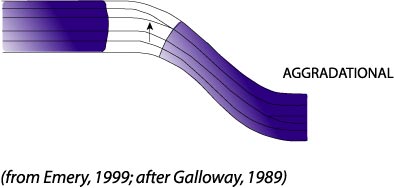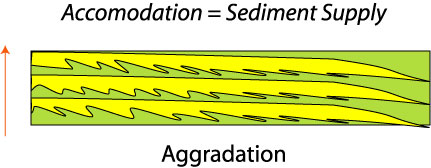|
accommodation
aggradation
aggradational parasequence set
progradation
progradational parasequence set
retrogradation
retrogradational parasequence set
transgression

|
Vertical build up of a sedimentary sequence. Usually occurs when there is a relative rise in sea level produced by subsidence and/or eustatic sea-level rise, and the rate of sediment influx is sufficient to maintain the depositional surface at or near sea level (i.e. carbonate keep-up in a HST [highstand systems tract] or clastic HST). Occurs when sediment flux = rate of sea-level rise. Produces aggradational stacking patterns in parasequences when the patterns of facies at the top of each parasequence are essentially the same (Posamentier, 1999; Wilgus et al.; 1988, Emery, 1996).



References
Emery, D., Myers, K.J., 1996, sequence stratigraphy. Blackwell, Oxford, UK, 297 pp.
Galloway, W.E., 1989, Genetic stratigraphic sequences in basin analysis. I. Architecture and genesis of flooding-surface bounded depositional units. American Association of Petroleum Geologists Bulletin 73, 125–142.
Posamentier, H.W., Allen, G.P., 1999, Siliciclastic sequence stratigraphy: concepts and applications. SEPM Concepts in Sedimentology and Paleontology no. 7, 210 p
Wilgus, C.K., Hasting, B.S., Kendall, C.G.St.C, Posamentier, HW, Ross, CA, and Van Wagoner, JC, eds., 1988, Sea-level changes: an integrated approach: Tulsa, OK, Society of Economic Paleontologists and Mineralogists, Special Publication No. 42, 407 p.
|